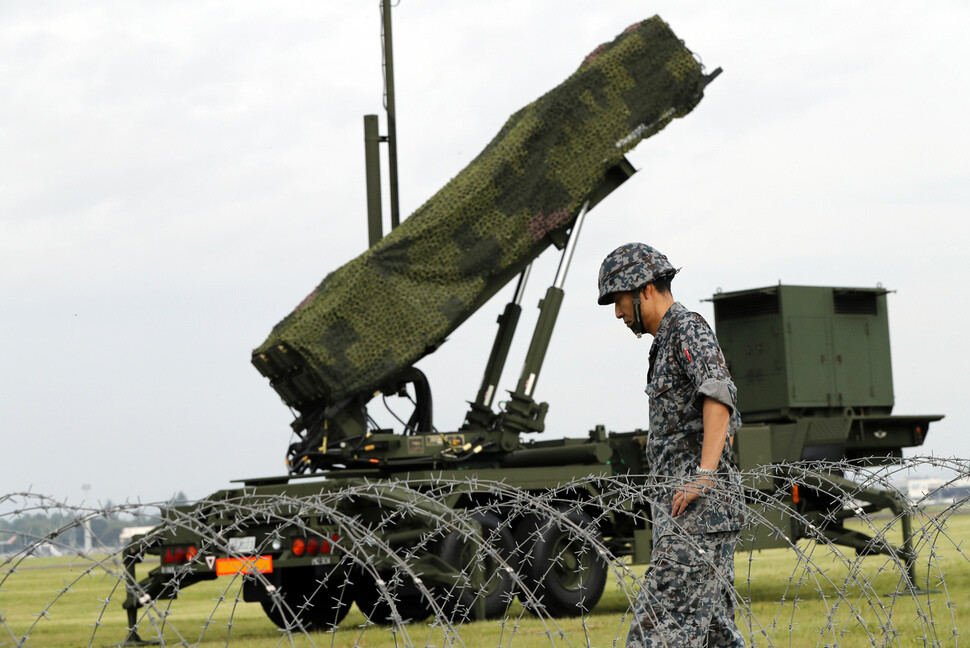hankyoreh
Links to other country sites 다른 나라 사이트 링크
Calls grow for Japan to increase military strength following North Korean missile launch

A North Korean missile’s recent passage through Japanese airspace is fueling support for beefing up Japan’s military strength.
Appearing at an ad hoc Security Committee meeting in the Lower House of the Diet on Aug. 30, Japanese Defense Minister Itsunori Onodera explained the reason the North Korean missile was not shot down.
“We did confirm the launch with radar, but determined there was no risk of it falling in Japan,” he said, sending the message that Tokyo could have shot the missile down but that such action was unnecessary.
Yet despite Onodera’s explanation, many in Japan are questioning whether the country actually does have the capability to shoot down a missile before it lands there, and are demanding efforts to boost its defense capabilities.
While the current Constitution is interpreted as following a principle of “exclusive defense,” or defending only in case of attack, conservatives in particular are calling to develop the ability to strike preemptively against North Korean missile bases. An Aug. 30 editorial in the Yomiuri Shimbun newspaper insisted that Tokyo should consider developing enemy base attack capabilities. When asked the same day whether such capabilities were being considered, Chief Cabinet Secretary Yoshihide Suga insisted that Tokyo “does not even possess the necessary equipment and does not plan to,” but also indicated it would “have to consider several possibilities going ahead.”
The Japanese government has recently used the North Korean threat as a justification for increasing defense spending and strengthening military capabilities. The Ministry of Defense recently requested a 2018 defense budget of 5.2551 trillion yen (US$47.6 billion) – its largest ever. As reasons for the hike, it cited concerns about Chinese maritime encroachment and a response to the North Korean threat. Major spending areas included the costs for Aegis Ashore, a land-based Aegis system to shoot down North Korean missiles, and research and development on the new SM-3 Block IIA missile interceptor, which is to be loaded on Aegis-equipped vessels.
Military technology research by private institutes is also being stepped up. The 104 total submissions for this year’s security technology research system, through which the Ministry of Defense provides support to private institutes and companies conducting basic military research, is more than double the 44 last year, the Asahi Shimbun newspaper reported.
Corporate submissions in particular more than quintupled to 55 from 10 last year. Ministry support is up to 11.0 billion yen (US$99.6 million) this year, from just 300 million (US$2.7 million) during the system’s first year in 2015. Where the use of private research toward military technology was once seen as taboo because of Japan’s militarist past, the arrival of the Shinzo Abe administration has seen efforts to actively use private basic science technology for military purposes.
A few critics have suggested the North Korean missile threat is being overblown. The Tokyo Shimbun newspaper noted that while Abe had claimed a “ballistic missile was launched toward our country,” the North Korean missile was not intended to strike against Japan. It also argued Abe’s reference to a “serious threat that has never before existed” was not clearly based in fact, as the latest missile was the fifth launched by North Korea this year to pass through Japanese airspace.
By Cho Ki-weon, Tokyo correspondent
Please direct questions or comments to [english@hani.co.kr]

Editorial・opinion
![[Guest essay] The real reason Korea’s new right wants to dub Rhee a founding father [Guest essay] The real reason Korea’s new right wants to dub Rhee a founding father](https://flexible.img.hani.co.kr/flexible/normal/500/300/imgdb/original/2024/0423/8317138574257878.jpg) [Guest essay] The real reason Korea’s new right wants to dub Rhee a founding father
[Guest essay] The real reason Korea’s new right wants to dub Rhee a founding father![[Column] ‘Choson’: Is it time we start referring to N. Korea in its own terms? [Column] ‘Choson’: Is it time we start referring to N. Korea in its own terms?](https://flexible.img.hani.co.kr/flexible/normal/500/300/imgdb/original/2024/0423/3617138579390322.jpg) [Column] ‘Choson’: Is it time we start referring to N. Korea in its own terms?
[Column] ‘Choson’: Is it time we start referring to N. Korea in its own terms?- [Editorial] Japan’s rewriting of history with Korea has gone too far
- [Column] The president’s questionable capacity for dialogue
- [Column] Are chaebol firms just pizza pies for families to divvy up as they please?
- [Column] Has Korea, too, crossed the Rubicon on China?
- [Correspondent’s column] In Japan’s alliance with US, echoes of its past alliances with UK
- [Editorial] Does Yoon think the Korean public is wrong?
- [Editorial] As it bolsters its alliance with US, Japan must be accountable for past
- [Guest essay] Amending the Constitution is Yoon’s key to leaving office in public’s good graces
Most viewed articles
- 1[Column] ‘Choson’: Is it time we start referring to N. Korea in its own terms?
- 2Why Korea shouldn’t welcome Japan’s newly beefed up defense cooperation with US
- 3[Guest essay] The real reason Korea’s new right wants to dub Rhee a founding father
- 4Opposition calls Yoon’s chief of staff appointment a ‘slap in the face’
- 5Senior doctors cut hours, prepare to resign as government refuses to scrap medical reform plan
- 6Terry Anderson, AP reporter who informed world of massacre in Gwangju, dies at 76
- 7[Column] The clock is ticking for Korea’s first lady
- 8[Editorial] Japan’s rewriting of history with Korea has gone too far
- 9New AI-based translation tools make their way into everyday life in Korea
- 10Survey: S. Koreans spend more time using smartphones than eating